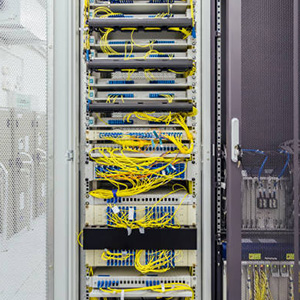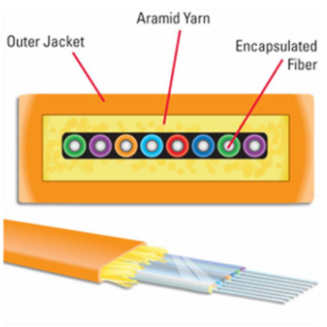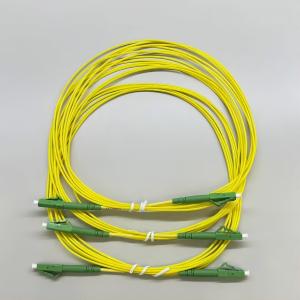Those who are familiar with fiber optic technology should know that Armored Fiber Cables have excellent stability and reliability, supporting additional protection to prevent loss of flexibility and functionality of fiber optic networks. At the same time, Armored Cables are also the best choice for outdoor environments, such as data centers and industrial applications. If you want to know more, you may wish to read Armored Fiber Cables Introduction
Armored Fiber Cable Basics
Armored fiber optic cables are much stronger and tougher than common cables, which are designed to withstand crush, pressure, and rodent issues. They possess high flexibility and durability when used in harsh environments or limited space.
When it comes to unarmored and armored fiber optic cables comparison, the distinctive difference lies in the outer protective layer. Precisely speaking, the armoring material doesn’t have to be metal, which can be fiber yarn, glass yarn, polyethylene, etc. The additional outer protective layer for optical cable makes the armored cable special, so the armored cables will be installed in locations that may expose to mechanical damages, while unarmored cables are normally used for control systems.

Armored fiber optic cable possesses several layers to secure the cable. The plastic outer jacket provides protection against rodents, abrasion, and twist. Then the light steel tube between the optic fibers and the outer jacket offers better protection to the fibers in the center. And the Kevlar is placed inside the outer jacket to cover the steel tube. The picture below presents a basic structure of armored cable, which may change accordingly to different usage occasions.

Armored Fiber Cable Types
The armored fiber cables can be classified into several types in terms of different classifications, which includes the type of metal tube within the cable, the installation methods of the cable, and the specific applications.
Classification According to Metal Tube
Armored fiber optic cable can be divided into two types according to the metal tube: interlock armored fiber cable and corrugated armored cable. Interlocking armor is an aluminum armor that is helically wrapped around the cable and found in indoor and outdoor cables, which offers ruggedness and superior crush resistance. Corrugated armor is a coated steel tape folded around the cable longitudinally, which can be found in outdoor cables and offers extra mechanical and rodent protection. Both armored fiber cables enable installation in the most hazardous areas, including environments with excessive dust, oil, gas, moisture, or even damage-causing rodents.

Classification According to the Installation Method
As mentioned before, there is a strong metal armored tube inside the armored fiber cable. Therefore, the termination of the armored fiber cable is more difficult than that of standard fiber optic cables. Field-terminated armored fiber cables have better performances in some outdoor applications, while pre-terminated ones are adopted by many installers for indoor applications considering quality transmission and time-saving factors.
Furthermore, the pre-terminated armored fiber cables provided by the market are mainly armored fiber patch cable and armored fiber trunk cable: the former is stronger and more flexible than the traditional fiber patch cable, while the latter is a length of armored fiber cable with several legs on each end terminated with fiber optic connectors.

Classification According to Application
Armored fiber cable can be used for indoor and outside plant (OSP) applications. According to different installation environments, tight-buffered armored cable and loose-buffered armored cable are generally adopted: Both loose-buffered and tight-buffered armored fiber cable can fit indoor and outdoor applications, but loose-buffered ones are more often used in outdoor applications.
Indoor Armored Fiber Cable: The armored cable used for indoor applications often consists of tight-buffered or loose-buffered with strength members and an inner jacket. The inner jacket is commonly surrounded by a spirally-wrapped interlocking metal tap armor. Typical indoor armored fiber cable types include GJFJV, GJFJZY, GJFJBV, GJFJBZY, GJFDBV, and GJFDBZY. With the fast development of fiber optic communication technology and the trend of FTTX, the demand for installing indoor fiber optic cables between and inside buildings is fast-growing.
Outdoor Armored Fiber Cable: Armored cable for outdoor is designed to ensure operation safety in complicated outdoor environments, and most of them are loose buffer designs. Light armor and heavy armor are the two versions of outdoor armored fiber optic cable. The light armored cable possesses the protective plastic jacket with the same durability and longevity of a stainless steel cable but in a lighter weight, which is suitable for a myriad of applications from interconnects to industrial and semi-harsh environment conditions. The heavy armored cable is wrapped in a wire circle that can protect the fibers from gnawing animals and damages that occur during direct burial installations, which is applied for the river bed and ocean floor.
Armored Fiber Cable Installation Guide
Armored fiber optic cable caters to both the rigorous environment of the outdoor but also can be routed indoors. Despite the numerous benefits armored fiber cable retains, it also yields some inconvenience to bond and ground the cable. To handle the problem that may occur during the installation, wisely perform the following steps.
- Bend Cable—Bend the armored cable about 10 inches from its end and squeeze with your hand until the coils of the armor come apart. If you can’t do this by hand, use pliers, or employ another cutting method.
- Twist Cable—Firmly grip the armored cable on each side of the cut and twist until the split-apart armor coil pops out, away from the wires. Use two pairs of pliers if you can’t do this by hand.
- Cut Exposed Coil—Using side cutters, cut the exposed coil of sheathing. You may have to grab the coil with the side cutters and work it back and forth to open and make the cut.
- Cut the Wires—If you are cutting a piece to length, slide back the sheathing and cut through the wires. Otherwise, slide the waste piece off and throw it away.
- Remove Excess—Cut off any sharp points of sheathing using side cutters. Remove the paper wrapping and any thin plastic strips.
Summary
If you want to buy Armored Fiber Cable, then FiberLife is your best option. We are one of the top providers of fiber optic solutions. Our wide range of products includes fiber patch cables, Polarization Maintaining Fiber cables, fiber trunk cables, SFP+, optical amplifiers, QSFP+, and a lot more.Get in touch with us today and learn more about our fiber optic products in detail.










